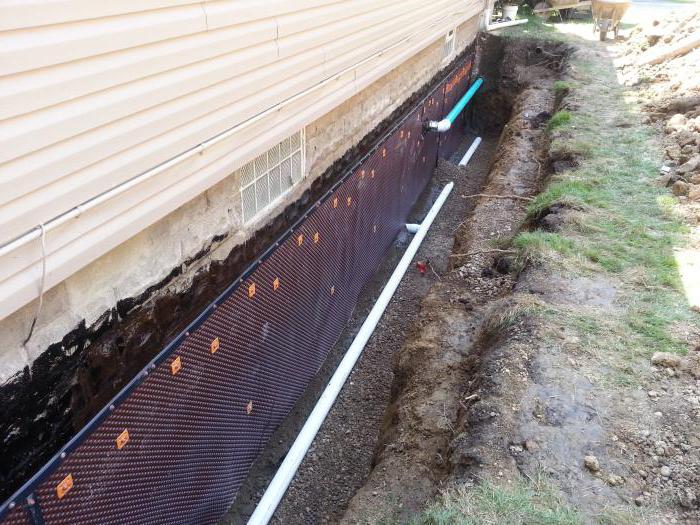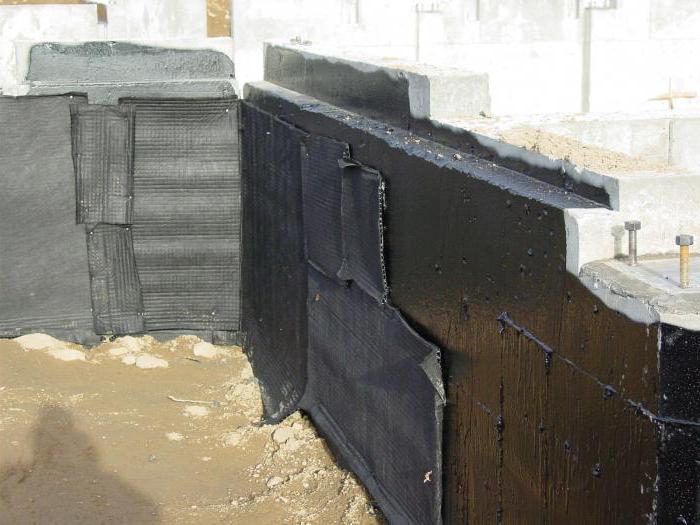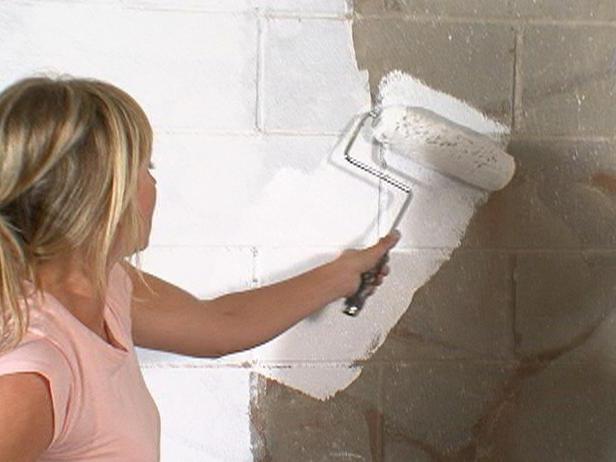Waterproofing of walls inside the premises: basic materials and technologies
In some houses, the smellmold, this is due to dampness. This is especially true of the basement and first floors, this occurs where the waterproofing has lost its integrity. Any building during the construction phase must be protected from moisture, this applies not only to the walls, but, of course, to the floor. As a source of moisture, underground water, air humidity and atmospheric precipitation can occur.
Waterproofing is especially important on the first floors, inbasements with masonry, as well as concrete foundations, which are easily saturated with moisture. It is necessary to carry out waterproofing of walls and in those premises where there is a probability of flooding, here it is necessary to carry:
- kitchen;
- bathrooms;
- swimming pools;
- toilets.

Basic Materials
Waterproofing of walls inside the premises is not importantonly in the house, but also in the underground space, which has recently been used very actively. There, too much moisture can be caused by uneven soil pressure, as well as shrinkage of the foundation and walls. If water penetrates into the basement, it begins to rise into the living space along an unprotected wall. In order to exclude such a phenomenon, it is necessary to carry out hydro and steam insulation of the walls.
To prevent moisture from precipitation, andunderground water did not harm the building, the relevant work is carried out. It is also necessary to prevent fungus and mold. To date, special rules and regulations have been drawn up, which are spelled out in the relevant documents.
Waterproofing of internal and external walls can be made with the following materials:
- expanding cement;
- penetrating mixtures;
- waterproofing membranes.
In the first case, we are talking about a material thatwhen solidified, increases in volume and fills the slits, as well as joints. Waterproofing of walls inside the premises can be carried out by penetrating mixtures, which are represented by:
- cement-bituminous materials;
- liquid glass;
- quartz sand.
The latter has a grain size distribution andhas chemically active additives. Use penetrating mixtures can be not only inside, but also outside buildings. Recently, a waterproofing membrane is often used, which is a polyethylene film with different densities. Among the components contain antioxidant substances, which improve the technical characteristics. The web may have a thickness in the range of 0.5 to 3 mm. Dense membranes are not as elastic as less thin membranes. To protect the walls from exposure to alkaline and acidic environment, you can also use injection materials.

Classification of waterproofing technologies depending on the purpose
Waterproofing of walls inside the premises can be classified according to the purpose. Given this parameter, the work can be directed to:
- sealing;
- antifiltration;
- Thermal insulation.
Work can also be carried out in order to stop corrosion processes.

Additional varieties of waterproofing for other factors
Depending on what material is used in the work, the waterproofing can be:
- okleechnoy;
- painting;
- plastering.
Depending on the features, we can distinguish the following types of waterproofing:
- single-layered and multilayered;
- reinforced, unreinforced;
- Ventilated with or without a protective layer.

Waterproofing technology for interior and exterior surfaces
Waterproofing of walls outside and inside canto be carried out by the method of horizontal or vertical application of materials. In the first case, it is an inexpensive and effective method, which can include the use of waterproof materials or an injection method that blocks capillaries, and the walls do hydrophobic.
Vertical waterproofing is not so effective,because it prevents the penetration of water into the building, but is not able to protect the walls from rising moisture in height. To create a fungus, this creates a favorable environment. This method is more effective in complex measures that involve horizontal and vertical deposition of materials.

Technology of lubricating waterproofing
Waterproofing of walls from inside the premises canIt is carried out by the lubricating method, which involves the use of polymeric materials, cement mastics and synthetic resins. The work is performed according to a certain algorithm. At the first stage it is necessary to level the wall in order to save materials. This is true for monolithic structures, on the surface of which it is necessary to perform a cement-sand screed.
For good adhesion, the wall should be coveredprimer, and then leave the surface to dry. Next, you can start applying a coating of waterproofing, among the recommended materials should be allocated:
- "Dispersant."
- "Cemisol 2EN".
- "Stirbit 2000".
- "Strimsmes".
- "Isobit DC".
- "Ascovil".
- "Cemisol 2EP".
If the wall consists of reinforced concrete structures, then it does not need to be leveled, and further technology remains the same.

Technology of penetrating waterproofing
Waterproofing from the inside canby penetrating materials, which are mixtures that block the pores of concrete at the capillary level. However, the concrete remains breathable. This method is used for monolithic reinforced concrete structures. Leveling of the surface is not required, and proper preparation involves removing the screed, if any, and cleaning the base with fleecy brushes made of metal.

Workflow Algorithm
The above technology of waterproofing the wall inThe apartment from the inside provides for cleaning the surface with brushes or sandblasting equipment. The goal is to remove dust and dirt from the base. The surface is treated with an antifungal agent or impregnated with water by spraying. Then you can start applying the waterproofing mixture. Its main purpose - protection from moisture, is complemented by an increase in frost resistance of concrete, as well as its resistance to corrosive environments.
It is especially necessary to processpotholes, cracks, holes, as well as those places where the walls are adjacent to each other. Among the materials for the waterproofing of walls inside the premises can be identified "Penetron" and "Infiltron-100". Next, we should tackle the seams, joints and joints with sutures. Use for this is recommended "Remstrim-T" or "Penecret". The treated surfaces must remain moist for the first three days, the coating should be smooth, without cracking and peeling.
Waterproofing with profiled membrane
Considering materials for waterproofing wallsfrom the inside, you should pay attention to the profiled membrane, which has many advantages, among others it is necessary to allocate a long service life, which reaches 50 years. In addition, the material is UV-resistant, safe for the environment, human health and retains elasticity when changing temperatures. The membrane is not corroded, it is resistant to low damage and chemical elements.
This method of waterproofing is also good for itseconomy, because the carrying out of concrete works does not require the expenditure of resources and resources. The installation is quite simple, therefore the work can be done qualitatively and quickly, especially when repairing. Waterproofing of walls inside the room with a membrane has one more nuance: films are more often used to eliminate excess moisture in basements. They are presented in the form of rolls. But if you want to carry out work on waterproofing in the toilet, bath or shower, it is better to use membrane-elastomers in liquid form. The layer is durable and elastic, it has no seams, and is applied by roller, brushes or in the form of a plaster mixture for tile or gypsum panels. ISOMAT SL 17 serves as an example of a liquid membrane.
Internal and external restoration of insulated deep walls
If the walls of structures and buildings are buried insoil, it is difficult to isolate and repair them. To ensure that groundwater does not penetrate into the depression, a drainage device is installed. For these purposes, it is possible to use a profiled membrane that is laid vertically. At the same time, water flows down channels without interference. The material is laid over the waterproofing of the wall, and its protrusions are turned towards the foundation. This will help remove the condensate that forms.
If restoration of waterproofing is necessarycarry out from the inside, then on the perimeter of the space of the room you need to install a drainage gap of 8 mm, it is formed when the membrane is fixed protrusions against the wall. Keep the air slots in the lower and upper parts. If the moisture seeps, then it will go to drainage. As an alternative solution is the creation of a false wall on a gypsum board frame.
Conclusion
Waterproofing walls in the apartment inside and outcan be carried out by different materials, among them bitumen and polymeric mastics, roll bituminous materials and penetrating, as well as penetrating mixtures. Bituminous materials, presented for sale in rolls, can be used for waterproofing walls, deepened into the ground. One side of the roll material is coated with a fine-grained quartz powder to increase the resistance to damage. Among modern roll materials, it is possible to distinguish "Hydroisol" and "Aquaizol".
Before choosing any type of waterproofingIt is necessary to decide whether you will carry out the work yourself. If this is the case, then the master should evaluate his abilities and skills. After all, if the technology is not implemented, it will be unrealistic to reach the goal, and the funds will be wasted. In addition, the work will take away the strength and time.
</ p>



